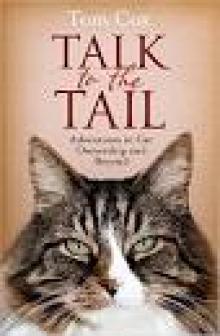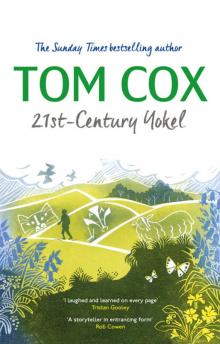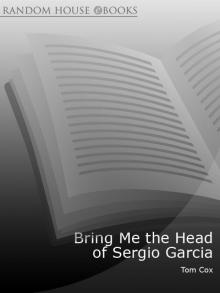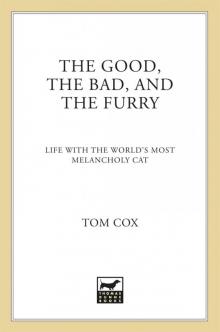Ring the Hill Read online
Also by Tom Cox
Help the Witch
21st-Century Yokel
Nice Jumper
Bring Me the Head of Sergio Garcia
Under the Paw
Talk to the Tail
The Good, The Bad and The Furry
Close Encounters of the Furred Kind
CONTENTS
Island-Hopping
Jenny Doesn’t Live Here
Nearly Northern
Minor Alps
Old Fat Bum
The Lion, the Witch and the Dress Code
Acknowledgements
A Note on the Author
Supporters
Copyright
‘For he conducted his life as
everyone does—by guessing at
the future’
—Annie Proulx,
Accordion Crimes
‘The man the hare has met
will never be the better of it
except he lay down on the land
what he carries in his hand—
be it staff or be it bow—
and bless him with his elbow
and come out with this litany
with devotion and sincerity
to speak the praises of the hare.
Then the man will better fare.
‘The hare, call him scotart,
big-fellow, bouchart,
the O’Hare, the jumper,
the rascal, the racer …
The creep-along, the sitter-still,
the pintail, the ring-the-hill …’
—Anon,
The Names of the Hare
(Thirteenth century)
ISLAND-HOPPING
(2018–19)
When you arrive at my house – my current house, which might not be my house for very long, since that increasingly seems to be the way of things with me – something you will probably notice about it before long is that it is in the sea. Not the extreme bottom of the sea, low tide perhaps revealing a chimney pot and the weatherworn edge of a seventeenth-century gable, but certainly not what could be considered officially part of the mainland. It’s a fact that makes itself more apparent on some days, and from some vantage points, than others. When the mist is heavy and you stand at the summit of one of the abrupt, isolated hills common to this part of Somerset, the realisation becomes stronger that, not all that many centuries ago, all the low ground as far as the eye can see was underwater: first proper sea, then a sort of marshy half-sea, dotted with small, tall islands, where semi-feral humans lived off fish and a king could successfully hide in times of trouble. I am fascinated by this place, and like it more every day, although I did not fall instantly in love with it. As most people who have got any kind of living under their belt know, though, the kind of love that arrives at first sight is rarely the most fulfilling.
I moved here at the beginning of the crisp, golden, hazy days: the period when, after the scruffiness of late summer, nature gets the decorators back in. It was a time of year that I already associated with the heart of Somerset and now probably will forever: the season when the region shows off its long, cosmic sunsets, the intricate embroidery of its skies, to best effect. In August I had made the mistake of boasting about a long period of excellent health and been summarily punished for my smugness with a back injury and chest infection, but the golden days kept stretching on and I was determined to make the most of them, so I hobbled out into the dry sea, past its sparkling coppery trees, coughing my way to the top of the island lookout points, doing a commendable amount of exploring for an invalid. I’d ordered the map before I’d booked the removal van: one of the lovely personalised ones the OS do nowadays, with your house at the dead centre. You get the privilege of choosing the cover photo yourself. Mine was one I’d taken on my first visit to Glastonbury Tor, in autumn 2015, at dusk, of the silhouettes of two Danish women watching the sun fall into the sea just below Weston-super-Mare, seventeen miles to the west. In Somerset and Dorset, more than in other coastal counties, I always get the impression the sun takes its nightly rest in the sea: nowhere too far away, but not quite in a spot you could easily swim or row a small wooden boat to.
I came to live here in the other sea – the inland sea that is mostly, but not always, dry – by accident; and then again I didn’t. Accidents are often an amalgamation of intentions, hopes, misfortunes and the knock-on effect of experiences, which arguably makes them not all that accidental at all. I impulsively left a part of the UK I love in order to live out a crazy, ambitious writing experiment in a brutally cold, topographically hostile spot; when I decided it was over, which was quite quickly, I ran back as soon as I could into the arms of part of the UK I loved but ended up in a house where I found it extremely difficult to work; I looked for a quieter, more private house to write in a couple of places which I thought might provide a balance between my social and working needs; I didn’t find one, but I fell, in a subtle way, for a house in another area, not all that far away, an area I didn’t know well at all. That all happened in under twelve months and accounts for why I am now in the sea. In other words, I am here as a direct result of being me. In this instance it has been expensive and tiring, being me, but I don’t regret it.
Twenty-one is the number of houses I have now lived in. I can’t claim full responsibility for that total. My parents moved a lot when I was growing up. In my ancestry, on the Irish side, there is evidence of travelling salesmen, so maybe that’s an additional explanation for the wanderlust. I’m disturbingly good at moving now: the packing, the labelling, the sizing up, the prioritising and deprioritising of bullshit admin. I wouldn’t say it gets easier, but doing stupid things during house moves in the past has, finally, after many years, made me marginally better at not doing stupid things during house moves. There is no better illustration of the human brain’s ability to blank out bad experiences as a coping mechanism than that of moving house. ‘Never again!’ we say, after a move, feeling like we have been slowly backed over three times by a large tractor with tyres caked in hot manure. But after a while, the details of exactly why it was so traumatic fade. ‘Maybe it wasn’t so bad after all?’ we think. But it was. Probably worse, in fact. Our memory is lying to us. If I was ever stuck for inspiration for writing, I would apply for a job as a removal man. It’s not just that removal companies see the intimate, behind-the-scenes paraphernalia of strangers every day; moving – stressful enough on its own – often happens when at least one other big life event is taking place. Bereavement, a break-up, a change of job, a financial crisis. It’s hard for people to keep their masks on when they’re mid-move. Movers see people stretched and fraught. They see a full flame ignited under stories that have been left on simmer for years.
I suspect my movers thought me oddly phlegmatic, my packing amazingly orderly, when they took my stuff from the edge of Dartmoor to east Somerset, but they were dealing with a rumpled relocation veteran. It was ultimately just another day in my peripatetic recent life. But I know, even so, from overhearing their banter, that they found amusement and intrigue in the quirks of my possessions. Why would anyone go to the trouble of buying this many books and records yet not replace that filthy, dented car, with all the bits hanging off it, or own any furniture made after 1972? ‘You’ve got a lot of lamps and plants, mate,’ one mover told me. ‘I have,’ I replied. ‘You’ve got a lot of lamps and plants, mate,’ his colleague told me, an hour or so later. ‘I have,’ I replied. I love the plants, and wouldn’t want to be without them, even though they don’t make moving any easier, and merely living with them is a much finer art than you assume, at times feeling like hosting a party attended by fourteen quiet but oddly high-maintenance friends, all of which you must keep constantly happy. ‘Jim needs a lot of encouragement to come ou
t of himself but don’t talk too loudly around Celia, and make sure Matilda always has a drink by her side even though her husband Bob is teetotal, and don’t worry if Greg seems very down and colourless early in the evening: he doesn’t really reach his best until 2 a.m. Also, don’t dance too close to Bianca or open the curtains suddenly when she is nearby if it is a nice sunny morning.’ The biggest of the lot – a vast Dracaena, taller than most rooms, which had lodged with me almost forever, in a huge pot full of earth and big pebbles, and which even the burliest of the removal men would not risk carrying alone – became very opinionated when I was experimenting with room arrangement, just when I thought I’d got through the move relatively unscathed. That’s where the back injury came from. A deranged disc, necessitating hundreds of pounds of chiropractor treatment. It wasn’t the Dracaena’s fault, though. It was mine for being an idiot, and, without evidence, believing myself to be in possession of the strength of a man four times my size.
All the same, I can’t deny that there is an awful lot I like about moving. I get obsessively excited about the idea of being out in a new area, exploring on foot. When I began to show small signs of nomadism in my twenties, it reignited an earlier worry of my mum and dad’s: that their house troubles during my childhood might have had a lasting psychological effect on me. If this is true then I view it only as a positive one. The six moves I’d been a part of by the time of my nineteenth birthday, plus the weekend walking trips we made to escape houses and jobs that were making my dad unhappy, are probably part of the reason I am now such an enthusiastic minor explorer, well-travelled in a small and unglamorous way. What a visit to the Harry Potter studios probably is to others, a visit to the headquarters of the Ordnance Survey – such as the one I took last summer – is to me. Discussions of the OS are probably the only time when I become truly patriotic. It is a place palpably full of love. All the employees seem to have been there forever – in some cases marginally longer. Martin Jones, a draughtsman I met, had worked there long enough to remember the summer of 1976, when, arranging a landscape in the record-breaking heat, he would often realise he had a tiny copse or church stuck to his forearm. He didn’t look nearly old enough to have been there that long. Clearly that was what working for the OS did for you. Now-adays, there is no need for miniature adhesive copses or churches, as everything is laid out and stored digitally: a rare instance in modern life where the transfer of an experience from three dimensions to two has not sapped it of nuance, perhaps has even furnished it with more nuance, since the zoom feature on the new digital OS maps allows an extra capacity for detail. Nonetheless, I stick evangelically with my paper versions, many of which are now flecked with farmyard mud or crimped by rainwater.
On the eve of my latest move, I spread a brand new, soon-to-be-mud-spattered OS map out before me, just as I had on the eve of my previous few moves. Immediately I could see plenty of intriguing stuff going on. Washing Stones Gully, less than a mile from my back door, caught my eye immediately. Over to the east, on the edge of thick woodland, there was something called Maggoty Paggoty. What on earth was that? Clearly it was mandatory that I soon walk the six and a half miles separating it from me and find out. I do not understand how anybody who loves art or language or detail can fail to love maps. What objects in everyday life are more endlessly magical, and more endlessly taken for granted? When it seems we are attempting to hastily cram more and more onto the surface of the land and blot out its mystery, maps offer solid evidence of something more permanent beneath all we have built in hurriedness and greed, something that will outlive our nonsense. Somerset, to me, especially at its heart, is the most map-like county to walk in. There are hills, but not so many that you can’t see the land spooling out in front of you for long distances. You crest them and, although you might not be in the greenest place in the whole country, you sense how much green is still out there. It is here that the sense of living in a palimpsest is at its most apparent: petrol stations, telephone exchange boxes, unimaginative new blobs of executive housing, sewage plants, concrete smears of agribusiness, they all tend to fade away. All the reassuring patterns of the earth are still there but much of what we have daubed on top is not. The situation looks better than it did when you were down in it.
Easily the most striking and famous of the islands above the dry inland sea, and one of the best viewpoints in the whole county, is the Tor at Glastonbury: alleged birthplace of British Christianity, alleged burial place of King Arthur and home of the Holy Grail, alleged gateway to the faerie underworld and alleged site of many other alleged events. The contrast of the surrounding low, fairly sensible, agricultural ground makes the Tor look all the more otherworldly, sticking up 521 feet into the heavens, with its pointy stone finger at the top. You can’t see it from my house because another less singularly shaped island is in the way, but it’s visible from virtually everywhere else within a ten-mile radius. The extended stone middle finger, which is all that remains of the fourteenth-century church of St Michael, always beckons rather than insults. I became hypnotised by it and felt it was vital that I travelled to it on foot as soon as possible after settling in.
I planned my route on the personalised OS map: it should not be much more than six miles, across mostly flat ground. But everywhere I went, footpaths seemed to have been blocked off by the local farmers. Electric fences had been strung across fields a matter of inches beyond stiles, leaving no room to circumvent the intangible produce they were protecting. Some stiles were only retrospective suggestions of stiles. Paths clearly marked on the rigorously detailed map petered out, unannounced, into raging tangles of bramble and overripe blackberries. I picked a few sloes from a hedge and sat on some sandy stubble, hot, bothered, and flummoxed. I decided I should probably file a report to Paul, who I met at the OS, whose job it is to keep Britain’s rights of way totally up to date. But then I remembered a story about an altercation between a farmer and a newcomer in a village near where I used to live – the details of the exact offence were blurred by time, but the image of a coffin set alight and left outside the front door remained in my mind – and I thought better of it. In the end, I was not totally unable to see the farmers’ point. Who precisely were they obstructing? Who actually walked around here, for fun? From the information I could gather, the answer was essentially just me. I could not help but appreciate the irony of the fact that I’d spent the last nine months living in two of England’s last remaining upland wildernesses – the Peak District and the edge of Dartmoor – yet it was here in this apparently benign flatland where I was facing some of my biggest challenges as a hiker. I was now edging, zigzagging, hare-like, into the more geometrical area of flatness west of my house: an area of arguable, somewhat fluid borders referred to as the Somerset Levels or Sedgemoor. Being a Dartmoor evangelist – never happier than in clean, acid air, walking through clouds, or climbing lichen-splattered boulders – I had scoffed at this idea of the sunken part of the landscape being cited as ‘moor’, but it had its own tricksiness, a stark mathematical wildness. With dead ends and detours, my route to the Tor turned out to be closer to ten miles than six, and the amount of time lost zigzagging through the sea meant that my plan to walk back had been scuppered.
I didn’t see the Tor at its best that evening. Dusk was coming on but the weather was a little drappy – a Somerset word I’d recently learned, which means ‘starting to rain slightly’. Even without the benefit of one of its legendary sunsets, the view from the top pushed you back onto your heels, opening the world’s mouth and allowing you to see humblingly down its throat. It is no surprise that people have been coming to this place on pilgrimages for thousands of years. Even if the bodies of King Arthur and Guinevere were not really found in the grounds of the ruined abbey down the hill in town, even if Joseph of Arimathea, great uncle and undertaker of Jesus, did not allegedly plant his staff across the valley in the earth of Wearyall Hill, causing the Glastonbury Thorn – and, by extension, British Christianity – to grow, travellers
would have been seduced and summoned by this tall island: a green ladder to the heavens which seems much closer to the celestial threshold than hills two or three times its height. Tonight there were the usual two dozen people milling about the doorless church at the summit and a man in the doorway, meditating. Few words were spoken. I counted three foreign accents, which was not at all unusual, and nine shawls, which was less unusual still. The view, though muted by weather, was vast and silencing. To the south-west, flanking the Polden Hills, the Levels stretched out, with their cross-hatching rhines: ribbons of water used to drain the marshy sea, where in the past a hungry person might annihilate an eel using a fork-like implement known as an eel prong, waiting, ideally, until the eel was asleep in the peaty side of the ditch, to make the task easier. To the north was the darkening grandstand of the Mendips. It was from their direction that in November 1539 the last Abbot of Glastonbury, Richard Whiting, was brought with two of his monks, on the orders of Henry VIII’s chief minister, Thomas Cromwell, fastened to a hurdle and dragged to the top of the Tor by horses, before being hanged, drawn and quartered where I now stood. As the light faded, above Wells (Britain’s fourth smallest city, where some of Whiting’s body parts were exhibited) the giant, glowing-red telephone mast began a dialogue with the Tor. There were other towers on hills nearby – the Hood Monument above Butleigh, the Pynsent Monument at Curry Rivel – but these two were the ones who had the big stuff to say to each other. ‘I am the now, and I’m what’s coming,’ said the telephone mast, ‘and I have no respect for any of this. Nothing that went before me matters.’ ‘You are taller in stature,’ replied the Tor, ‘I’ll give you that. But that is only one kind of size. I dwarf you in every other way. You would not even begin to be able to guess at the multitudes I contain.’

 Ring the Hill
Ring the Hill Talk to the Tail
Talk to the Tail Help the Witch
Help the Witch Educating Peter
Educating Peter Nice Jumper
Nice Jumper 21st-Century Yokel
21st-Century Yokel Bring Me the Head of Sergio Garcia
Bring Me the Head of Sergio Garcia The Good, the Bad, and the Furry
The Good, the Bad, and the Furry